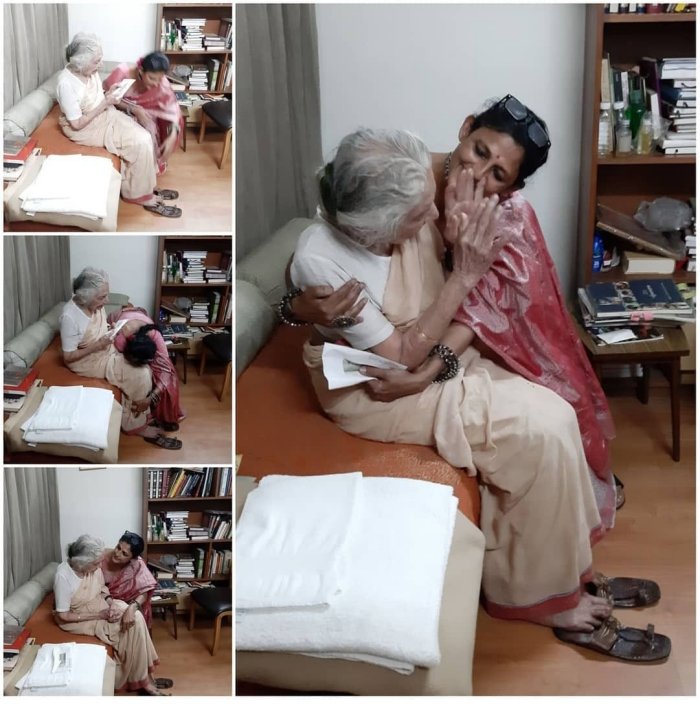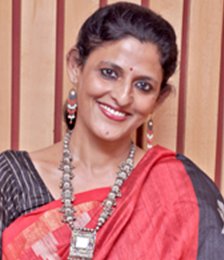 |
  |
 |
  |
My tribute to my Guru
- Navina Jafa e-mail: navina.jafa@gmail.com September 19, 2020 Dr. Kapila Vatsyayan, once called the Czarina of Indian Culture, was a legendary scholar on Indian culture. An administrator, institution builder, scholar, and dancer all packed in one. Her comprehension of the journey in understanding the seeds lying in the internal soils of India and Asia to the ephemeral fragrance was unmatched. My journey with her started at the age of 10 and a half when she was our neighbor in Satya Marg. We often shared time over dinners, shopping, and walks. She became my affiliated guide for my Ph.D. along with Dr. Narayani Gupta at the Jamia Milia Islamic. Here are some excerpts from my diary: "How can you go to the fragrance of a flower? Well, you need to understand the soil in which the seed is nurtured, then the journey of the plant, and then the flower. But most times, the journey begins and ends with the fragrance, something that dissolves as soon as it is released." Her Visual, Performing Arts in-depth knowledge and training in archeology, numismatics, literary and spiritual traditions covered the wide span of Indian, Asian, and Western Aesthetics. She could speak in-depth about the organic multi-media on the 13th c poem 'Geet Govind' and the Blue Series of Pablo Picasso all in one breath. She could map the idea of the Science of Modern Dance movement, say of Laban and with microscopic surgical eyes and then contextualize that understanding to the Natyashastra for the Modern Practitioner. She launched legends like Pt Birju Mahraj, Yamini Krishnamurti, and took Balasaraswati for her first concert abroad as much as she built landmark institutions (CCRT, Schools of Buddhist Studies, IGNCA). Her zeal was to reclaim, preserve, and think about Indian culture accepting its complexity of holistic sensibility. It was as much about protecting as it was about preserving the creative communities of this country. (Most grants in the Ministry of Culture were planned and started by her, even one awarded to Sonal Mansingh in the early part of her career).  POLITICS CAN WORK ONLY WHEN CULTURAL GEOGRAPHIES ARE UNDERSTOOD, NEGOTIATED TO CREATE COEXISTENCE: "Culture is the response to geographical contexts." The only way power can work when those in power respect local cultural world views. How can the person living in the Northern Indian Plains understand the context of the cold desert of Ladakh? Or how can the person on the Western coast of Mandavi relate to the forest community in Bandhavgarh? Conversations, dialogues need to happen so that negotiations happen, and multiple streams' coexistence becomes a reality. INDIA- THE WORLD & GEOPOLITICS - Hers was a futuristic aerial vision that remained well ahead of time. I had returned from rigorous research in Ladakh. Soon after, in one of our Sunday garden walks, she said, "Our political borders are so vulnerable and unchartered. Geopolitics' strategy is not about placing thousands of troops on the coast or land borders; it is about comprehending to include the people on the margins and the borders. The troops' man-in-charge is on a 'posting' and the Border people are permanent soldiers. It was so important to involve, for instance, HH, The Dalai Lama, to build strong border cultural communities in the Himalayas through the thread of Buddhism. His wisdom and other Tibetan scholars and knowledge streams were not only about addressing the fragile Indian Buddhist Cultural Heritage, but engagement with the exiled Tibetans was ways to build the communities on the Border." Dr. Vatsyayan was the one who suggested to Pt. Nehru and Maulana Azad the idea of Higher Buddhist Study Institutions like the one in Sarnath, Sikkim, Ladakh, and in other places. His Holiness continued to call her "Mother." Her eyes caught talent and worked to understand the idea of India better - Spiritual leaders, Shankaracharya, Sufi scholars from Kashmir, and Mata Amritanandamayi, among many others. They felt honored to dialogue with her. Leading Indian and World Scholars like Stella Kramisch, Bettina Baumer, Dr. Roger Lipsey, John McKim Malville, to name a few, worked with her. THE 'ASIA PROJECT' of the INDIA INTERNATIONAL CENTRE was once again ahead of time. Dr. Vatsyayan already knew not EVENTS like festivals, but knowledge networks with Asian nations will pave the way for India to invest in a rooted manner to lead Asia. IGNCA - Conceived as the Indian version of the SMITHSONIAN, she once shared her drawings and thoughts that she kept. "India, with its rich, diverse cultural capital, can be the leader to drive hard politics. IGNCA is that concept and that tool. There is a map to that concept," she said, comprehending India's approach to create the holistic legacy of the past (not parochial divisions). The Geet Govind Multimedia Project - "Everybody laughs at me and says, Kapila, what are you doing with this small 13th c Radha-Krishna love-story? You know what I discovered. This small little poem was the story of the Indian subcontinent's organic ethos of multimedia. It is written, painted, danced, sung, and created as a ritual. The poem is an entry path to linguistic nuances as much as to the key to understand cultural geographies." - Creating International Dialogues. Dr. Vatsyayan had launched in the form of extraordinary exhibitions, an ecology of creating sustainability for cultural ecosystems, cultural skills, and creative communities. From Documentation, Exhibition to Sustainability was her motto. "Cultural Diplomacy is not about onetime events. It is about starting dialogues, about conversations, about questioning, and critiquing!" From Nordic countries to Europe and America, her participant list had the best. An example of this was her program titled 'Mind, Man, and Mask.' In our several talks over dinner, I learned the manner she conceptualized such a complex program. - To address the Mind's idea, she got a range of national and international scholars who worked on psychology, Mind, and creativity ET. - For Man - It meant scholars and practitioners engaged with studies of human societies. - For Mask - It was performing arts and crafts. She did invest in younger people, although she was a difficult old time guru. Some names include: Late Premola Ghosh, Teteii L.S. Tochhawng, and the team of the India International Centre (who is called her 'Girls'), Amar Behl (designer), Himani Pande, Dr. Advaitvanidini Kaul, Dr. Mouli Kaushal, Vaswati Mishra (dancer), Rekha Tandon, and a few others. An entry in my diary reads - (KV) Dr. Kapila Vatysyayan - "Culture is similar to weaving. If you are the weaver, then respect all the colors in the threads. Respect the dynamics of the weft and the warp. It is only then you can optimize the functionality of human communities. This is the strength of culture - the idea of diversity. If you suppress diversity, you kill the human community." That day, Kapilaji and I listened to Kabir's "Jhini re jhini re jhini chadariya." Last week I called, and she was irritated. "You always call at the wrong time! I am going to a meeting at the India International Centre!" I was happy that in COVID time, despite some health issues, she was back with her spirit to live. (To be 91 years old and all set for a meeting. Wow, what zest to live). For that energy, one cannot but thank those who worked to take care of our National Treasure - Mr. Ramachandra, Amita, Vishwajeet, her driver, and the India International Centre's entire world. Before we put down the phone, she said what were going to be the last words to me. "I am sitting on the platform for quite some time waiting. I am glad you are all set for creative work. Jeeti Raho!"  Navina Jafa did her Phd on socio-economics, and aesthetics in the world of Kathak Dance in 6 urban towns of North India under Dr. Kapila Vatsyayan and urban historian Prof. Narayani Gupta. She learned Kathak from Gurus Pt. Birju Maharaj, Munna Shukla and Reba Vidyarthi. A Fulbright scholar at the Smithsonian Museum, she worked on cultural management and diplomacy. She runs a business on Academic Tourism and is vice president of Centre for New Perspectives presently working to create sustainable livelihoods for marginalized street-folk performers. Post your comments Please provide your name and email id along with your comment. All appropriate comments posted with name and email id in the blog will also be featured in the site. |